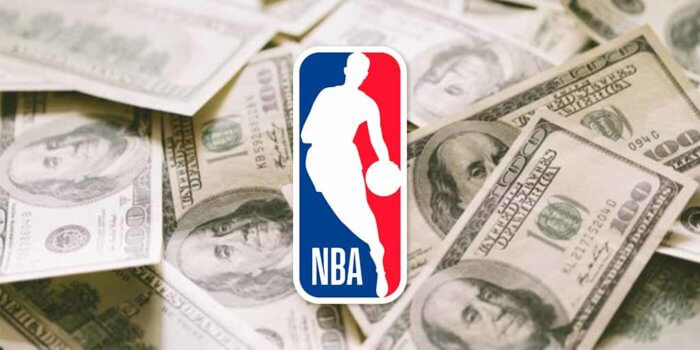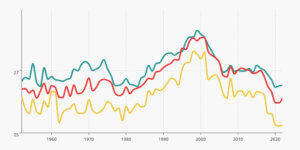During the inaugural 1946 NBA season, the highest-earning player in the league was Tom King of the Detroit Falcons with a yearly salary of $16,500. The reason he was the highest paid player in the league? He got paid for being a player as well as the teams business manager AND publicity director!
Since then, things have changed drastically. Salaries in the NBA had been rising steadily for decades, but the last TV deal in 2016 supercharged this development and increased salaries by over 60% within only 3 years.
It's fair to say, that NBA players don't have to worry about feeding their family, but just how rich are they really? Let's find out!
How much does an average NBA player make?
The average NBA player earns $8.5M during the 2021-22 season.
For this analysis I used data from basketball-reference.com. Salary data is not officially reported by the NBA, so these numbers might not be 100% accurate, but they should be close enough to give a very good idea of the evolution of NBA salaries. To clean up the data I removed 10-day players and two-way contracts and only looked at players earning at least the relevant minimum salary.
We can see that the average salary during the 1990-91 season was just below $1M and has grown by over 8x since then to around $8.5M in 2021-22.
From 1991 to 2009 the average salary grew consistently before hitting a rough spot following the financial crisis in 2008 and the subsequent new collective bargaining agreement in 2011 that lowered player salaries from 57% of basketball related income to around 50%.
Before the 2016-17 season the NBA signed a new TV deal with ESPN and Turner Sports worth roughly $2.6B a year (up nearly 200% from the previous deal) and we can see the explosion of salaries after the deal was signed. Average NBA salary grew from $5.2M in 2016 to $8M in only 3 years!
From 2020-21 to 21-22 salaries didn't grow any further, probably a result of revenue losses due to the Covid pandemic.
Average NBA Salary by Position
Taking a look at salary by positions it's interesting to see that from 1990-2000 Center was the highest paid position every year. Dominant big guys like Patrick Ewing, Shaq, Alonzo Mourning or David Robinson are among the most expensive players during this period.
From 2000, power forwards take over the top spots but we can still observe a clear trend where big guys are consistently paid better than other positions.
This changed around 2020 where all of the sudden point guards are the best paid players in the NBA with Steph Curry, Russell Westbrook and James Harden ranking 1-3 in 2022.
Table 1: Average Salary in the NBA by Pos:
| Year | Average Salary | PG | SG | SF | PF | C |
|---|---|---|---|---|---|---|
| 2022 | $8.5M | $10.8M | $7.9M | $7.5M | $9.2M | $7.7M |
| 2021 | $8.5M | $11.4M | $6.9M | $7.6M | $8.8M | $8.1M |
| 2020 | $8.2M | $10.4M | $6.8M | $7.9M | $7.8M | $8.5M |
| 2019 | $8M | $8.2M | $6.6M | $8.1M | $7.7M | $9.3M |
| 2018 | $7.4M | $7.3M | $7.3M | $7.1M | $7.4M | $8.1M |
| 2017 | $6.3M | $6.3M | $5.7M | $6.5M | $6.2M | $7M |
| 2016 | $5.2M | $5.3M | $4.3M | $5.6M | $5.3M | $5.6M |
| 2015 | $4.8M | $4.6M | $4.1M | $4.5M | $5.4M | $5.5M |
| 2014 | $5M | $4.7M | $4.3M | $4.6M | $5.5M | $6M |
| 2013 | $4.8M | $3.9M | $4.5M | $4.4M | $5.8M | $5.4M |
| 2012 | $4.7M | $4M | $4.6M | $4.8M | $4.5M | $5.4M |
| 2011 | $4.7M | $4.2M | $4.9M | $4.4M | $4.7M | $4.8M |
| 2010 | $4.9M | $4.1M | $5.2M | $4.6M | $5.1M | $5.4M |
| 2009 | $4.9M | $4.5M | $4.8M | $4.8M | $4.9M | $5.2M |
| 2008 | $4.7M | $4.4M | $4.4M | $4.7M | $4.8M | $5M |
| 2007 | $4.3M | $3.6M | $4.1M | $4.7M | $4.1M | $4.9M |
| 2006 | $4.2M | $3.6M | $4.1M | $4.1M | $4.7M | $4.1M |
| 2005 | $3.9M | $3.4M | $3.5M | $3.7M | $5.1M | $3.9M |
| 2004 | $3.9M | $3.2M | $4.2M | $3.5M | $4.6M | $3.8M |
| 2003 | $3.8M | $3M | $3.9M | $3.6M | $4.6M | $3.9M |
| 2002 | $3.5M | $3M | $3.3M | $3.5M | $4.2M | $3.4M |
| 2001 | $3.4M | $2.7M | $3.5M | $2.9M | $4.1M | $3.9M |
| 2000 | $3.1M | $2.5M | $3.1M | $2.6M | $3.5M | $3.7M |
| 1999 | $2.6M | $2.1M | $2.1M | $2.5M | $2.9M | $3.3M |
| 1998 | $2.3M | $1.9M | $2.5M | $2M | $2.1M | $2.9M |
| 1997 | $2M | $1.8M | $2.1M | $1.9M | $2.2M | $2.2M |
| 1996 | $1.7M | $1.7M | $1.5M | $1.7M | $1.8M | $2M |
| 1995 | $1.5M | $1.4M | $1.4M | $1.6M | $1.4M | $1.6M |
| 1994 | $1.3M | $1.1M | $1.3M | $1.3M | $1.4M | $1.5M |
| 1993 | $1.1M | $0.9M | $1.1M | $1M | $1.2M | $1.4M |
| 1992 | $1M | $0.9M | $0.9M | $1M | $1.1M | $1.2M |
| 1991 | $0.9M | $0.8M | $0.8M | $0.8M | $0.8M | $1.1M |
How Much Do NBA Starters and Bench Players Make?
Graph 3: Average Salary in the NBA by Starters / Bench Players:
In 2022, NBA bench players made on average $4.2M while starters made $14.9M
For this analysis, I defined bench players as players who started less than half of their games and starters as players that started more than half of their games.
Unsurprisingly, starters have always earned more than bench players, but lately the difference has grown tremendously. In 2019, starters made about 2.5x compared to bench players. In 2021/22 this increased to almost 4x!
Distribution of Salaries in the NBA
Graph 4: Interactive Chart of # of Players per Salary Bucket per Year
An average salary of $8.5M sounds amazing, but the salaries of NBA players are not distributed evenly at all. In 2021/22, five players made more than $40M of yearly salary (Steph Curry, Russell Westbrook, James Harden, Lebron James and Kevin Durant) while 93 players made less than $2M.
The median salary in 2021/22 is $4,347,600, that means that 50% of NBA players make less than $4,347,600. So average salary is heavily skewed by a few players making insane amounts of money, while most of the NBA makes much less.
Another way to measure the inequality of the distribution of salaries is the Gini coefficient. It's a number between 0 and 1, where 0 shows a perfectly equal population (so every NBA player would make the exact same amount) and numbers close to 1 show a very unequal society (Lebron James makes $1B and the rest plays for free).
Graph 5: Gini coefficient of NBA incomes and US household incomes
We can see that the Gini coefficient spiked significantly from 1995 - 1997 following the signing of a new collective bargaining agreement but has been relatively stable since then.
Overall, a gini coefficient around 50% is quite high and shows a significant level of inequality in the NBA. NBA salaries are also distributed more unequally compared to American household data gathered from the US census bureau.
NBA salaries by Player Age
Going through the raw numbers of the data I collected I thought it would be interesting to take a look at salaries vs production of NBA players. You often hear that NBA players are paid for past performance, not necessarily how good they are right now.
Is this really the case?
Graph 6: Average Salary and PPG by Age in the NBA
From the graph we can see that points per game production peaks at age 28 (at 10.1ppg), while salary peaks much later at 33 (where ppg have dropped to 8.13).
The shape of both lines are very similar but salary correlates best with the production 4 years prior. So mathematically speaking, NBA players get paid according to their PPG from 4 years ago.
NBA Salary by Player Height
There is an old saying in basketball: "You can't teach height". That made me wonder whether big players are actually paid more since they are harder to come by than 6ft point guards?
Salary by Size:
The scatter chart shows that there is no perfect correlation between size and average salary but we can definitely observer a trend were taller players are paid more on average than smaller players.
Between 1990 and 2022 and filtering for heights with at least 100 player-seasons, players at 5'11 (DJ Augustin, Ty Lawson) were the cheapest while players at 7'1 (Shaq O Neal, Rudy Gobert etc.) where the most expensive.
Final Thoughts
For this article I gathered a lot of information on stats and salaries from basketballreference.com and cleaned it to allow for easy analysis.
Is there anything interesting that I missed? Let me know in the comments and I'll add it to the article!

Founder of thehoopsgeek.com. A passionate basketball enthusiast and coding geek, Andy combines a love for sports with technology.







